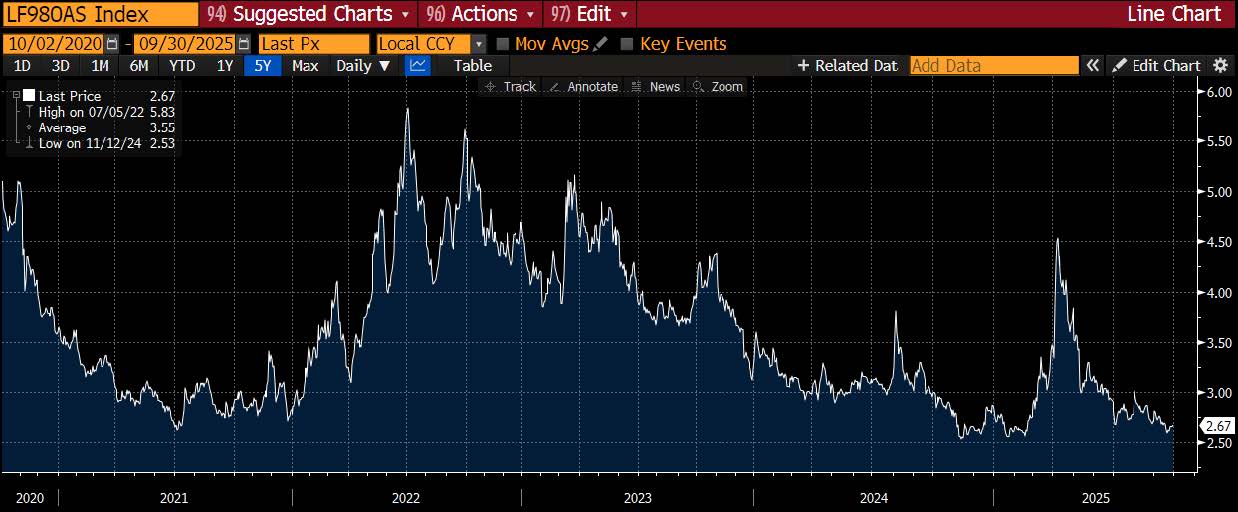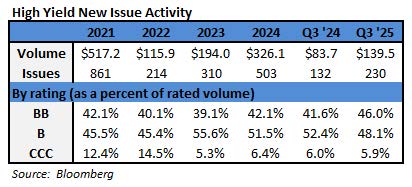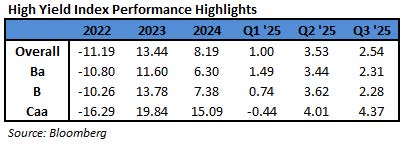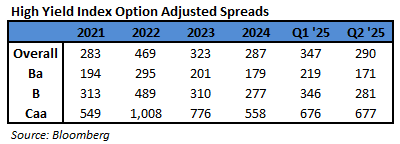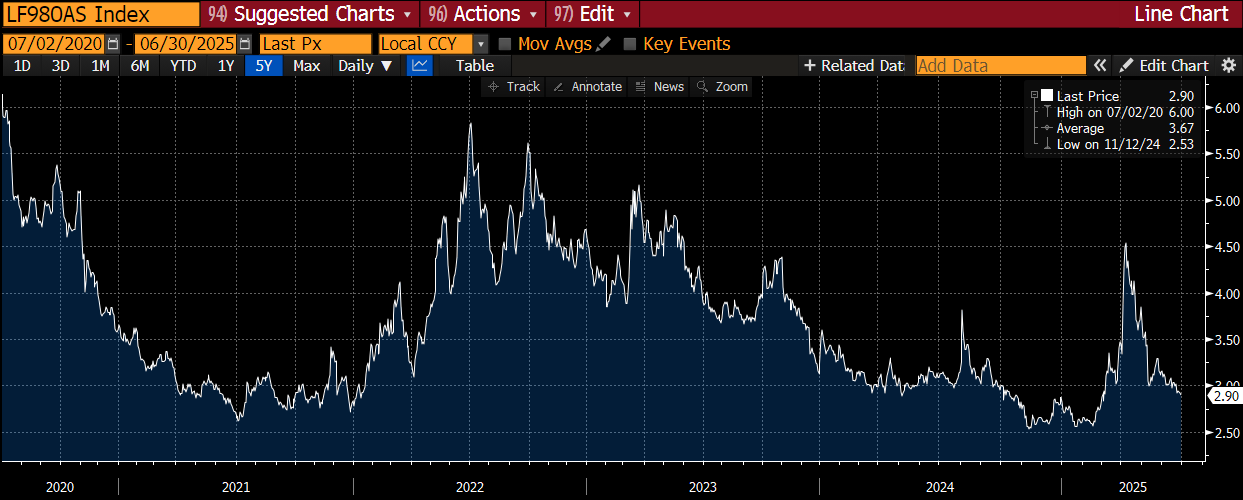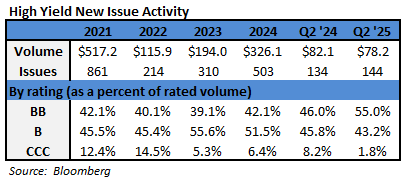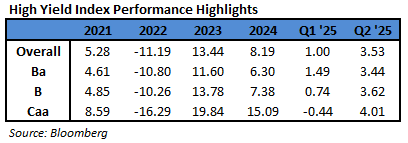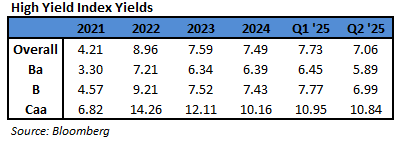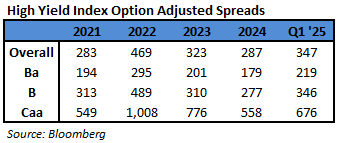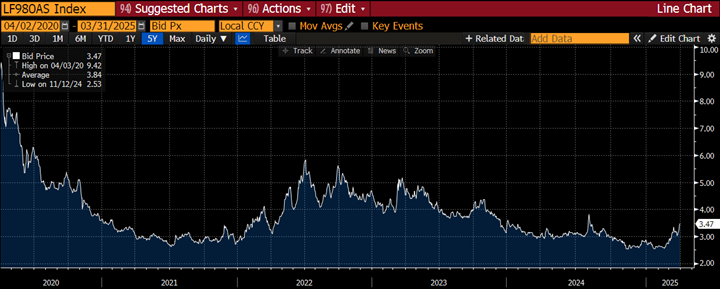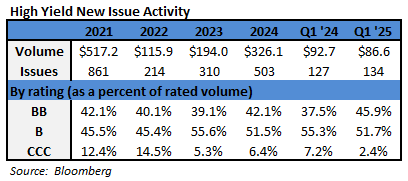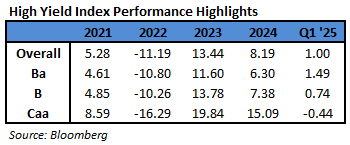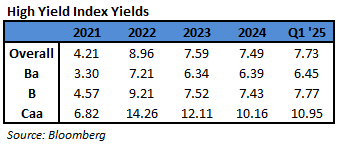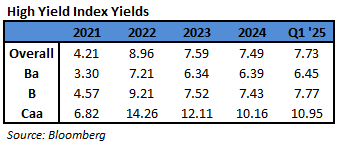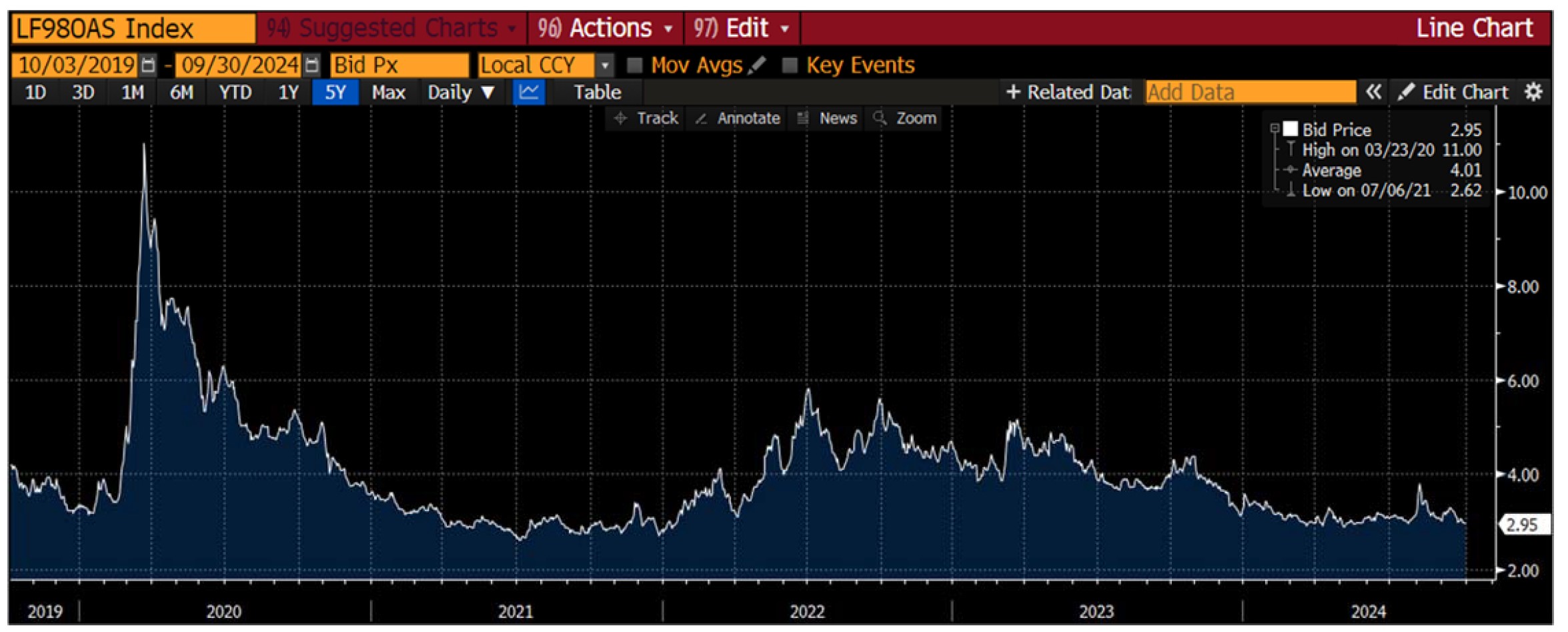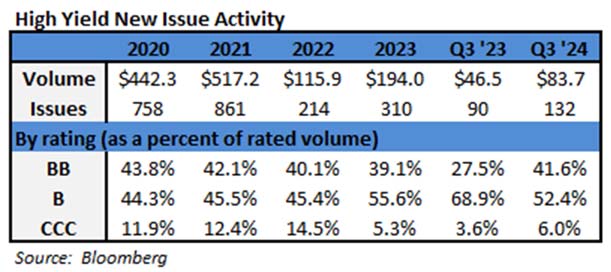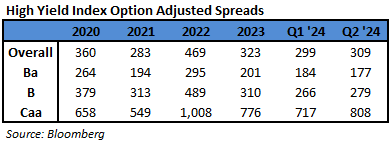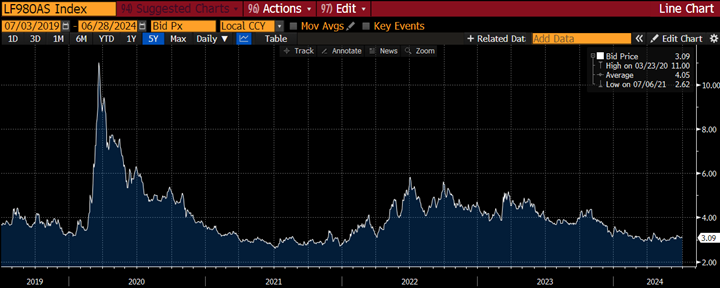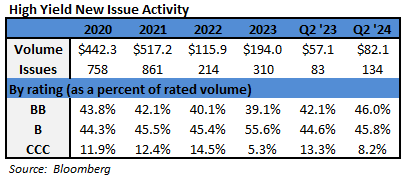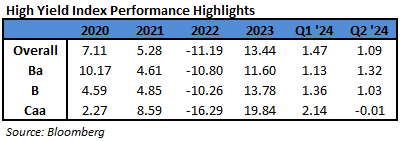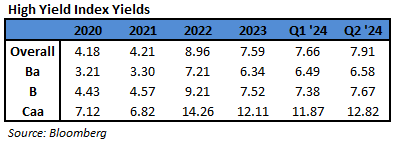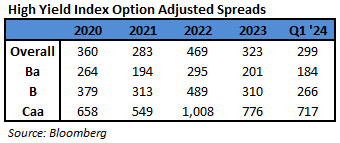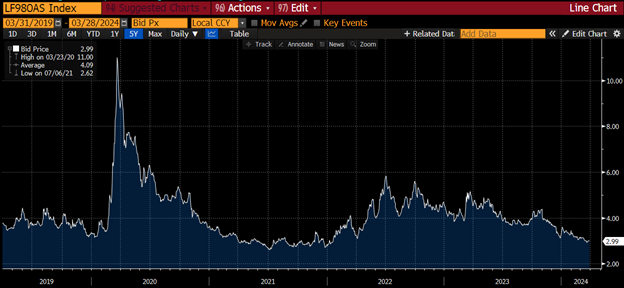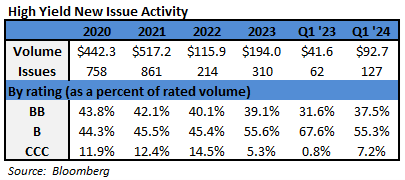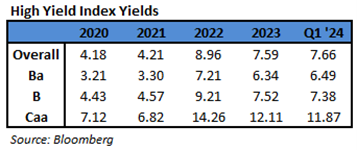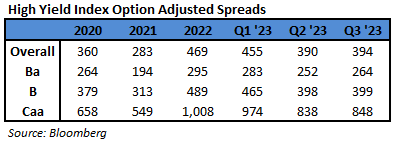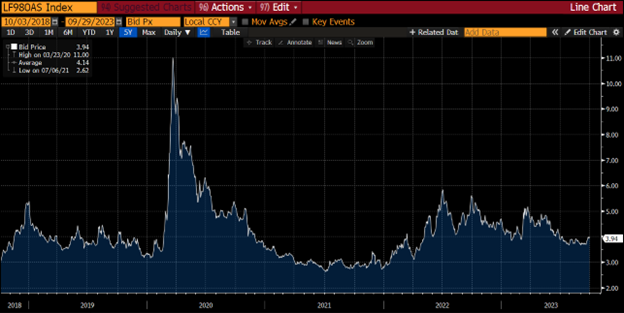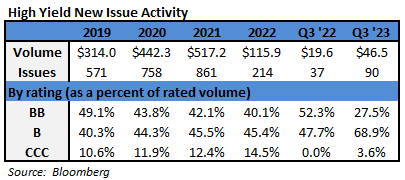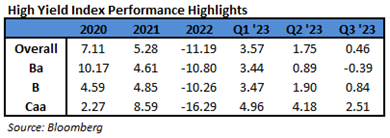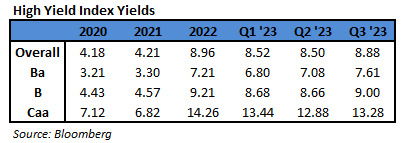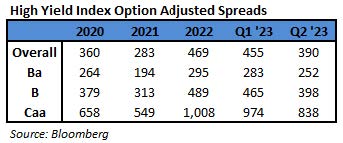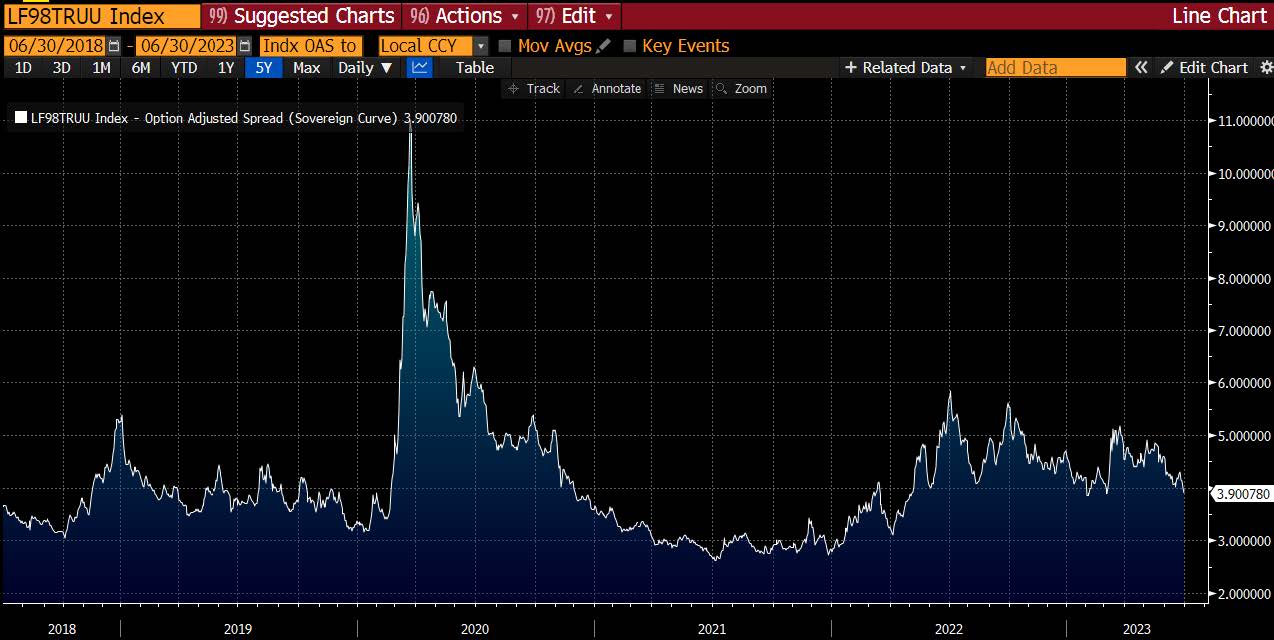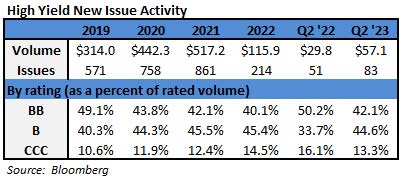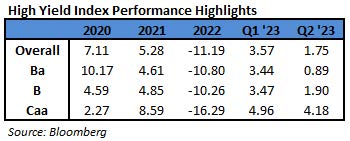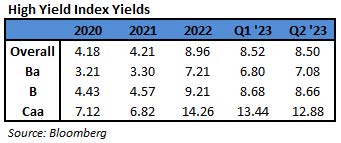Q3 COMMENTARY
October 2025
In the third quarter of 2025, the Bloomberg US Corporate High Yield Index (“Index”) return was 2.54% bringing the year-to-date (“YTD”) return to 7.22%. The S&P 500 index return was 8.11% (including dividends reinvested) bringing the YTD return to 14.81%. Over the period, while the 10-year Treasury yield decreased 8 basis points, the Index option-adjusted spread (“OAS”) tightened 23 basis points moving from 290 basis points to 267 basis points.
With regard to ratings segments of the High Yield Market, BB-rated securities tightened 3 basis points, B-rated securities tightened 18 basis points, and CCC-rated securities tightened 73 basis points. The chart below from Bloomberg displays the spread move of the Index over the past five years. For reference, the average level over that time period was 355 basis points.
The sector and industry returns in this paragraph are all Index return numbers. The Index is mapped in a manner where the “sector” is broader with the more specific “industry” beneath it. For example, Energy is a “sector” and the “industries” within the Energy sector include independent energy, integrated energy, midstream, oil field services, and refining. The Communications, Other Industrial, and Energy sectors were the best performers during the quarter, posting returns of 3.61%, 3.29%, and 2.88%, respectively. On the other hand, Technology, Capital Goods, and Basic Industry were the worst performing sectors, posting returns of 1.42%, 1.89%, and 1.93%, respectively. At the industry level, media, refining, and healthcare REIT all posted the best returns. The media industry posted the highest return of 5.74%. The lowest performing industries during the quarter were packaging, paper, and chemicals. The packaging industry posted the lowest return of 0.17%.
Issuance
The first half of the year had fairly strong issuance with Q1 posting $86.6 billion and Q2 posting $78.2 billion. The third quarter continued the strong trend but posted true blowout issuance of $139.5 billion. Of the issuance that did take place during Q3, Discretionary took 28% of the market share followed by Communications at 16% and Financials at 14%.
The Federal Reserve did hold the Target Rate steady at the July meeting and then made a 25 basis point cut at the September meeting. There was no meeting held in August. The current Fed easing cycle stands at 125 basis points in total cuts and kicked off in September of last year. However, the recent cut was the first cut in 2025. The Fed dot plot shows an additional 50 basis points of cuts expected for the year. Currently, market participants are pricing in an implied rate move of 47 basis points in cuts for 2025 making their forecast right in line with the Fed.i
After the September meeting, Fed Chair Jerome Powell commented on the weakening labor market. “Labor demand has softened, and the recent pace of job creation appears to be running below the break-even rate needed to hold the unemployment rate constant,” Powell told reporters. He added, “I can no longer say” the labor market is “very solid.”ii Inflation remains a concern for the Fed with a worry that tariffs have yet to fully work through the system. A softening labor market and stubborn inflation is a tough needle for the Fed to try and thread. That leaves some differing opinions on the best forward rate path. In fact, seven of the nineteen members project zero additional cuts in 2025. Powell acknowledged the varied perspectives and noted it is currently a “meeting-by-meeting situation.”
Intermediate Treasuries decreased 8 basis points over the quarter, as the 10-year Treasury yield was at 4.23% on June 30th, and 4.15% at the end of the third quarter. The 5-year Treasury decreased 6 basis points over the quarter, moving from 3.80% on June 30th, to 3.74% at the end of the third quarter. Intermediate-term yields more often reflect GDP and expectations for future economic growth and inflation rather than actions taken by the FOMC to adjust the target rate. The revised second quarter GDP print was 3.8% (quarter-over-quarter annualized rate). Looking forward, the current consensus view of economists suggests a GDP for 2026 around 1.8% with inflation expectations around 2.7%.iii
The Bloomberg US Corporate High Yield Index ended the third quarter with a yield of 6.70%. Treasury volatility, as measured by the Merrill Lynch Option Volatility Estimate (“MOVE” Index), has moved below the 80 index average over the past 10 years. The current rate of 73 is well below the spike near 200 back during the March 2023 banking scare. The most recent spike reached a high of 140 in April of 2025 as the market grappled with numerous tariff changes. The MOVE Index has maintained a downward trend since the April spike. Data available through August shows 22 bond defaults this year which is relative to 16 defaults in all of 2022, 41 defaults in all of 2023, and 34 defaults in all of 2024. The trailing twelve-month dollar-weighted bond default rate is 1.88%.iv The current default rate is relative to the 1.85%, 2.13%, 1.72%, 1.98% default rates from the previous four quarter-end data points listed oldest to most recent. Defaults are generally stable and the fundamentals of high yield companies are in decent shape. From a technical view, fund flows were positive this year through August data at $14.1 billion.v No doubt there are risks, but we are of the belief that for clients that have an investment horizon over a complete market cycle, high yield deserves to be considered as part of the portfolio allocation.
The high yield market performed well throughout Q3. As the quarter closed, the government went into a shutdown as Congress failed to reach a budget agreement. These shutdowns have historically created more headline-driven volatility than any lasting market dislocations. They happen during Republican and Democratic administrations alike and vary quite a bit in length. Since 1990, there have been 6 previous shutdowns which lasted an average of 14 days. However, the range of the previous 6 shutdowns has been between 3 days and 35 days. There will certainly be plenty to evaluate as we move to finish out the year. Our exercise of discipline and credit selectivity is important as we continue to evaluate that the given compensation for the perceived level of risk remains appropriate. As always, we will continue our search for value and adjust positions as we uncover compelling situations. Finally, we are very grateful for the trust placed in our team to manage your capital.
This information is intended solely to report on investment strategies identified by Cincinnati Asset Management. Opinions and estimates offered constitute our judgment and are subject to change without notice, as are statements of financial market trends, which are based on current market conditions. This material is not intended as an offer or solicitation to buy, hold or sell any financial instrument. Fixed income securities may be sensitive to prevailing interest rates. When rates rise the value generally declines. Past performance is not a guarantee of future results. Gross of advisory fee performance does not reflect the deduction of investment advisory fees. Our advisory fees are disclosed in Form ADV Part 2A. Accounts managed through brokerage firm programs usually will include additional fees. Returns are calculated monthly in U.S. dollars and include reinvestment of dividends and interest. The index is unmanaged and does not take into account fees, expenses, and transaction costs. It is shown for comparative purposes and is based on information generally available to the public from sources believed to be reliable. No representation is made to its accuracy or completeness. Additional disclosures on the material risks and potential benefits of investing in corporate bonds are available on our website: https://www.cambonds.com/disclosure-statements/.
i Bloomberg October 1, 2025: World Interest Rate Probability
ii Bloomberg September 17, 2025: Fed Cuts Rate by Quarter-Point; Powell Cites Weakness in Jobs
iii Bloomberg October 1, 2025: Economic Forecasts (ECFC)
iv Moody’s September 15, 2025: August 2025 Default Report and data file
v Bloomberg October 1, 2025: Fund Flows

